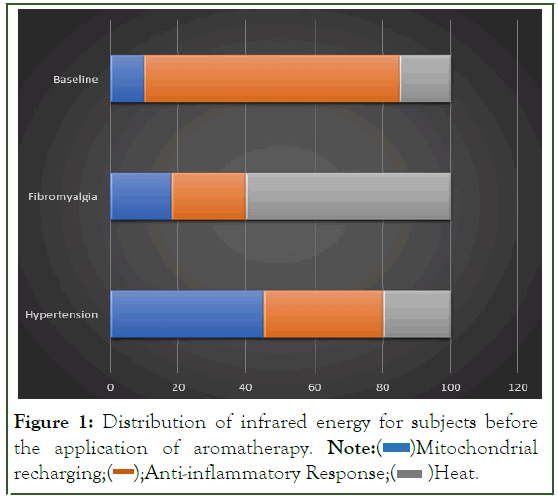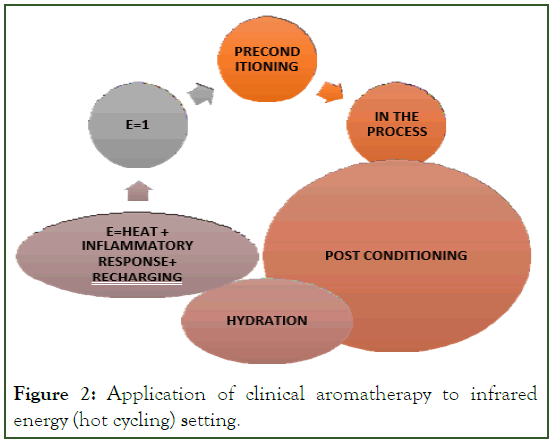Indexed In
- Open J Gate
- Genamics JournalSeek
- ResearchBible
- RefSeek
- Directory of Research Journal Indexing (DRJI)
- Hamdard University
- EBSCO A-Z
- OCLC- WorldCat
- Scholarsteer
- Publons
- MIAR
- Euro Pub
- Google Scholar
Useful Links
Share This Page
Journal Flyer

Open Access Journals
- Agri and Aquaculture
- Biochemistry
- Bioinformatics & Systems Biology
- Business & Management
- Chemistry
- Clinical Sciences
- Engineering
- Food & Nutrition
- General Science
- Genetics & Molecular Biology
- Immunology & Microbiology
- Medical Sciences
- Neuroscience & Psychology
- Nursing & Health Care
- Pharmaceutical Sciences
Case Report - (2023) Volume 12, Issue 6
A Case Study to Verify a Hypothesis Involving Mitochondria, Anti-Inflammation, and Heat Generation in an Exercise Environment with Infrared Energy
Fai Chan*Received: 28-Nov-2023, Manuscript No. BABCR-23-24297; Editor assigned: 30-Nov-2023, Pre QC No. BABCR-23-24297 (PQ); Reviewed: 15-Dec-2023, QC No. BABCR-23-24297; Revised: 21-Dec-2023, Manuscript No. BABCR-23-24297 (R); Published: 29-Dec-2023, DOI: 10.35248/2161-1009.23.12.518
Abstract
A new trend in exercise is exercising in an environment with an infrared energy source. A hypothesis involving mitochondria receptors, anti-inflammation, and heat generation is proposed based on data reported by 20 individuals in such an environment. A case study was conducted to examine the hypothesis and the application of clinical aromatherapy to improve the outcome.
Keywords
Hypertension; Fibromyalgia; Anti-inflammation; Mitochondria; Heat; Aromatherapy; Infrared
Introduction
A person’s cholesterol level affects his health. Increased level of cholesterol increases the risk of cardiovascular diseases [1]. Research shows that exposure to infrared energy can reduce a person’s cholesterol level [2]. In conjunction with the study on the effects of infrared energy on cholesterol, this paper discusses the benefits of applying clinical aromatherapy in an infrared exercise environment for individuals who are healthy, who are experiencing hypertension and who are experiencing fibromyalgia.
Case Presentation
The author separates the commercial uses and clinical uses of this emerging exercise regimen. Many patients seek infrared technology due to its immunity boosting and regeneration properties [3]. Also, infrared technology can deliver benefits such as anti inflammation, weight loss, skin rejuvenation, mental clarity, and boosting of energy. Is one of the listed benefits precede all others? If one adopts the oxidative stress theory, then anti inflammation and anti-oxidant should be the key factors [4]. Free radicals cause inflammation and aging. It is a common belief in medical society that reducing free radicals improves the ability of an individual’s body to recover from an ailing state. This article attempts to examine the operation of infrared energy in more detail. More specifically, this article attempts to describe how cell mitochondria fights inflammation in the body (inflammatory response) by recharging hot/cold receptors with infrared energy. This article will discuss (a) the theoretical sensitivity of recharging mitochondria with respect to the changes in heat generation, (b) body anti-inflammation, and (c) the benefit of applying clinical aromatherapy. Real cases will be added to illustrate the theory.
Definition
Infrared (IR) in this article is defined as electromagnetic radiation that have wavelengths between 780 nm to 1000 μm [5].
Hypothesis
The infrared energy is distributed into 3 areas: recharging (in mitochondria), anti-inflammatory response and heat generation [6,7]. The heat in the body can be divided into internal and external heat. When a human body is exposed to infrared energy, the heat generated is mainly internal with external heat as peripheral. As individuals have more expose to infrared energy, they become more tolerant to cold environments. Also, when an individual is exposed to infrared energy more often, the time for the heat in that individual’s body to dissipate also increases. The build-up of heat may cause an individual to experience mild fever. Some individuals attempted more frequent exposure to infrared light can boost body immunity and reported less inflammation, headache, or pain. As for recharging, it is targeting at mitochondria in recharging itself for increasing activity level and/or mending malfunctioning [8].
Figure 1 shows the distribution of infrared energy in different categories. In this figure, the total amount of infrared energy is 1. Subjects of Baseline, Fibromyalgia, and Hypertension were picked for examination.

Figure 1: Distribution of infrared energy for subjects before the application of aromatherapy. Note:  Mitochondrial recharging;
Mitochondrial recharging;  Heat.
Heat.
In base line group, infrared energy is distributed into 10% mitochondria recharging, 75% anti-inflammation, and 15% Heat.
In Fibromyalgia group, the distribution is 18% in mitochondria recharging, 22% in anti-inflammation, and 60% Heat.
In Hypertension group, the distribution is 45% in mitochondria recharging, 35% in anti- inflammation, and 20% Heat.
The data in Figure 1, was obtained from a study of 20 individuals. Out of the 20, 8 were baseline (normal), 5 had Fibromyalgia or rheumatoid arthritis, and 7 had high blood pressure. The participants were asked to rate (from a scale of 1 to 10) their energy level, inflammatory response (occurrences of headaches), and the heat they experienced. The fewer the headaches, the larger the number is. They gave their ratings before and after exercise.
Each subject was cycling under the exposure of infrared light for 15 minutes.
The data in Figure 1, suggests that a combination of infrared energy and exercise may help or hurt one’s ailment [9]. It is best for an individual with a certain ailment to study the energy distribution prior to implementing such a regimen.
Because the combination of infrared energy and exercise can produce a significant amount of heat in some individuals, a way to help individuals to reduce the heat buildup is through the application of clinical aromatherapy.
Figure 2, shows the stages of the study. Preconditioning is prior to exercise. The application of aromatherapy is done through the spray of rose water on neck or upper back or the application of peppermint cream on knee cap. Those treatments reduce body heat and increase the anti-inflammation of individuals with hypertension. In the process is during exercise. A method of reducing body heat during this stage is using Gua Sha scrapper on legs and shoulders. Post conditioning is after the exercise. An application of aromatherapy is spraying rose water on neck or upper back just like how it was done during preconditioning.

Figure 2: Application of clinical aromatherapy to infrared energy (hot cycling) setting.
The author suggests drinking water or energy drinks after exercise to replenish the fluids lost due to sweating.
The build-up of heat in a person’s body can increase the metabolism of the body. For some ailments, the heat must be dissipated through sweating to avoid any damage or adverse effect in the body. Infrared light produces more anti- inflammatory response for a given amount of body heat compared to conventional heating.
While increased body heat and mild sweating is good for detox and expulsion of excessive salt in the body, the body of an individual with high blood pressure is more inflamed (manifested in redness of skin) with heat buildup. During the summer, water aerobics allows an individual to exercise with less heat buildup. This is due to the fact that water helps cool the body. During the winter, an infrared sauna also allows an individual to exercise with less heat buildup. This is due to the fact that the body absorbs infrared energy for purposes other than generating heat.
Results and Discussion
To demonstrate the application of clinical aromatherapy, the author applied the techniques mentioned earlier to an individual with high blood pressure. This individual practiced yoga in an infrared sauna. This individual experienced pain and lack of energy afterwards. This individual also had fibromyalgia.
The author advised this individual to apply a ketone rich nano lotion (with peppermint cream, eucalyptus, rosemary, and lavender) on the area with pain. After several exercise sessions, this individual reported normal face color, reduced pain, increased mobility, higher energy level, absence of rapid heartbeat, and no shortness of breath. No other aromatherapy product was used.
Conclusion
The hypothesis states that mitochondrial recharging leads to improved anti-inflammation response and reduced heat generation of human body. A case study involving an individual using clinical aromatherapy appears to confirm this hypothesis. The introduction of infrared sauna setting for exercises appear to gain popularity. However, the actual efficacy and safety of such exercise environment requires more study.
References
- Jeong SM, Choi S, Kim K, Kim SM, Lee G, Park SY, et al. Effect of change in total cholesterol levels on cardiovascular disease among young adults. J Am Heart Assoc. 2018;7(12):e008819.
[Crossref] [Google Scholar] [PubMed]
- Gryka D, Pilch W, Szarek M, Szygula Z, Tota L. The effect of sauna bathing on lipid profile in young, physically active, mail subjects. Int J Occup Med environ Health. 2014;27(4): 608-618.
[Crossref] [Google Scholar] [PubMed]
- Shui S, Wang X, Chiang J Y, Zheng L. Far-infrared therapy for cardiovascular, autoimmune, and other chronic health problems. Exp Biol Med (Maywood). 2020;245(14):NP1.
[Crossref] [Google Scholar] [PubMed]
- Pizzino G, Irrera N, Cucinotta M, Pallio G, Mannino F, Arcoraci V, et al. Oxidative stress: Harms and benefits for human health. Oxid Med Cell Longev. 2017:8416763.
[Crossref] [Google Scholar] [PubMed]
- Tsai SR, Hamblin MR. Biological effects and medical applications of infrared radiation. J Photochem Photobiol B. 2017;170:197-207.
[Crossref] [Google Scholar] [PubMed]
- Marchi S, Guilbaud E, Tait SW, Yamazaki T, Galluzzi L. Mitochondrial control of inflammation. Nat Rev Immunol. 2023;23(3):159-173.
[Crossref] [Google Scholar] [PubMed]
- El-Gammal Z, Nasr MA, Elmehrath AO, Salah RA, Saad SM, El-Badri N, et al. Regulation of mitochondrial temperature in health and disease. Pflugers Arch. 2022;474(10):1043-1051.
[Crossref] [Google Scholar] [PubMed]
- Chan F. Reexamining ketone replenishment in the healing of inflammatory issues, its pros, and cons, and therapeutic dosages from discovery, application and review, Proceedings of the 4th Edition of International Conference on Traditional Medicine, MAGNUS Group.2022.
- Hamblin MR. Mechanisms and applications of the anti-inflammatory effects of photo biomodulation. AIMS Biophys.2017; 4(3):337-361.
[Crossref] [Google Scholar] [PubMed]
Citation: Chan F (2023) A Case Study to Verify a Hypothesis Involving Mitochondria, Anti-Inflammation, and Heat Generation in an Exercise Environment with Infrared Energy. Biochem Anal Biochem. 12:518.
Copyright: © 2023 Chan F. This is an open-access article distributed under the terms of the Creative Commons Attribution License, which permits unrestricted use, distribution, and reproduction in any medium, provided the original author and source are credited.

